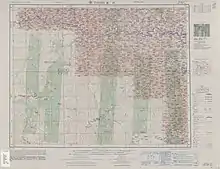縣
| ||||||||
Translingual
| Traditional | 縣 |
|---|---|
| Shinjitai | 県 |
| Simplified | 县 |
Han character
縣 (Kangxi radical 120, 糸+10, 16 strokes, cangjie input 月火竹女火 (BFHVF), four-corner 62993, composition ⿰⿱⿴𠀃三小系(GTV) or ⿰県系(HJK))
Descendants
References
- KangXi: page 934, character 23
- Dai Kanwa Jiten: character 27784
- Dae Jaweon: page 1373, character 8
- Hanyu Da Zidian (first edition): volume 5, page 3435, character 11
- Unihan data for U+7E23
Chinese
| trad. | 縣 | |
|---|---|---|
| simp. | 县 | |
| alternative forms | 県 | |
Glyph origin
| Historical forms of the character 縣 | ||
|---|---|---|
| Western Zhou | Shuowen Jiezi (compiled in Han) | Liushutong (compiled in Ming) |
| Bronze inscriptions | Small seal script | Transcribed ancient scripts |
 |
 |
 |
Shuowen: Ideogrammic compound (會意) : 𥄉 + 系 – to hang 系 by the head 𥄉 (hair hanging down).
Original form of 懸. Originally in bronze and bamboo slip scripts, Ideogrammic compound (會意) : 目 + 木 + 糸 - to hang with the string 糸 by the head 目 (using an eye to represent a head) on a tree 木. In Qin bamboo slip scripts, some of 目 + 木 were corrupted to 県 (with one straight horizontal line rather than 𠃊) which interpreted to a reversed 首 head by Shuowen, and 糸 was corrupted to 系.
Etymology 1
(This etymology is missing or incomplete. Please add to it, or discuss it at the Etymology scriptorium.)
Pronunciation
Definitions
縣
- A type of administrative division:
- (historical, in ancient China) district; prefecture
- (in Mainland China) county (third level division that is now generally restricted to rural areas, contrasted with urban districts (區/区 (qū)))
- (in Taiwan) county (first level division that used to be under the jurisdiction of a province but are now directly administered by the central government)
- (in Japan) prefecture
- (in the United States) county (second level division under the jurisdiction of a state, excluding Alaska and Louisiana)
- (in many cases but not always) county seat (the town which serves as the seat of government of such divisions)
- a surname
See also
Compounds
|
Descendants
Others:
Pronunciation
Definitions
縣
- † Alternative form of 懸/悬 (xuán, “to hang; to suspend”).
- 不狩不獵,胡瞻爾庭有縣鶉兮? [Pre-Classical Chinese, trad.]
- From: The Classic of Poetry, c. 11th – 7th centuries BCE, translated based on James Legge's version
- Bù shòu bù liè, hú zhān ěr tíng yǒu xuán chún xī? [Pinyin]
- You do not follow the chase;
— How do we see the quails hanging in your courtyards?
不狩不猎,胡瞻尔庭有悬鹑兮? [Pre-Classical Chinese, simp.]
Japanese
| 県 | |
| 縣 |
Kanji
(“Jinmeiyō” kanji used for names, kyūjitai kanji, shinjitai form 県)
- This term needs a translation to English. Please help out and add a translation, then remove the text
{{rfdef}}.
